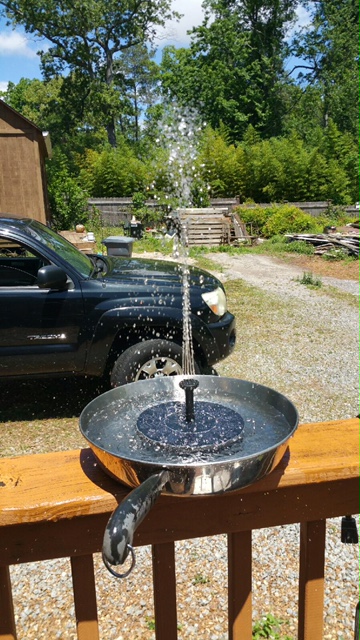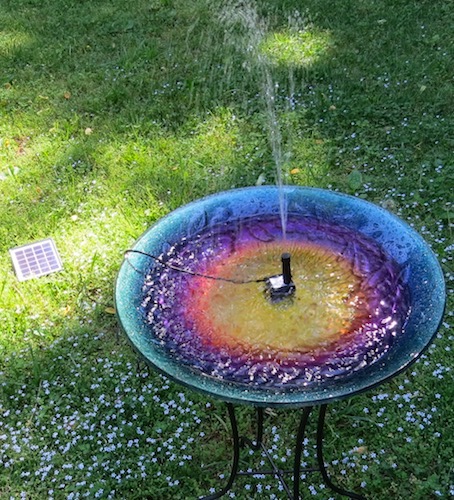-
Happy New Year… Deep Freeze Calls for Heated Bird Bath
Resolve to help birds thrive in freezing weather…
When temperatures are soaring in the midst of summer, it’s pretty obvious to remember water for feathered friends and wildlife. We’re outdoors more often, gardening and relaxing- so filling the birdbath becomes intuitive. But throughout winter months, and especially in freezing weather we tend to prefer the cozy warmth of staying inside. But birds require fresh water regardless of the time of year or temperatures.
Some of the more hard core bird lovers will make the daily trudge through snow and ice to clear, clean and fill feeders (that’s us!). Several heated bird baths around our place remain ice-free (and worry-free) as resident birds are seen daily drinking from them. Although bathing is not as popular in freezing weather… water is critical for drinking!
A popular birding magazine with an expert article mentioned that birds can fend for themselves when it comes to water in winter. Melting ice and snow for example will provide water. BUT during a week-long deep freeze in Atlanta recently, there was zero precipitation (luckily) – which means there was no melting ice and no snow. So… that theory’s not really valid.
Fresh water is so important yet so easy with a heated bird bath or a simple heater added to your existing bath. It’s an oasis for year-round use (just tuck the cord) and they come in several styles like deck-mounted, tall pedestal or heated ground baths. In many cases, a heater will keep your ceramic or cement birdbath from freezing and cracking as well.
Nab a heated bird bath for this winter season. It’s a one-time investment that offers an ongoing, essential element to help wild birds thrive in cold winter months.
-
Why are Ground Bird Baths More Natural?
Because Birds Bathe More Naturally at Ground Level!
Think about it… before humans ever started offering bird baths for feathered friends, they got along just fine with shallow pools of water and puddles.
Freezing temperatures likely created some problems as the shallows froze over, making it more difficult for birds to find water. The concept of eating snow for water seems logical- but if you’re a bird it’s pretty much half baked!
The reason being is that it takes energy to convert the snow to liquid. This energy requires calories and it’s the calories birds spend all day consuming in cold weather. From dawn until dusk, most of the resident backyard birds will be at feeders and foraging for enough calories to make through another night. Calories provide the energy to keep warm, although nature has provided other mechanisms for that too!
You know when puffed up, big fat birds are hanging around feeders and they resemble little fluff balls? Feathers are fluffed as a way to trap heat beneath them close to the birds’ body. It’s one of the main reasons for late summer/fall molt when they shed old and tattered feathers. New feathers are sturdy, sometimes even brighter and more effective at keeping the bird warm.
So by offering shallow open water in winter, you help birds conserve energy. And since ground bathing comes more naturally, heated ground baths absolutely rock for winter! Easy to add a heater to an existing bath, or go for one with concealed heater- meant for year-round use.
The Four Seasons Ground Bath is ideal for it’s size, rough texture and hidden heater.
Birds will flock to it in frigid weather as the design resembles those natural shallow pools and puddles. It helps create a perfect winter habitat along with feeders and shelter, and once weather warms up, simply tuck the cord underneath the bath!
-
Red Neck Solar Bird Bath
Could it be… the red neck version of a solar bird bath? Maybe so, but we’re betting birds can’t tell the difference and won’t mind one bit!
Because fresh water is the best (and easiest) way to attract feathered friends, just about any vessel, bowl, container or bird bath works- provided the water is fresh and not too deep. Yes, even a frying pan!
A major misconception that’s actually dangerous for birds, is birdbaths that are too deep. There’s a good reason birds use shallow puddles to bathe as water should be no more than about 2 inches deep. No need to fill your bird bath to the top, it makes a scary encounter for birds, especially juveniles in spring and summer.
And if there were ever a few good reasons to keep bird bath water moving, think Zika, West Nile or EEE (that’s Eastern equine encephalitis) which are all mosquito-borne viruses.
Solar bird baths absolutely rock for feathered friends as moving water acts as a visual magnet to entice them for bathing. Water stays fresher and nasty mosquitoes are unable to lay their eggs.
Speaking of rock (or rocks), placing a few stones or large rock in your birdbath helps birds with safer footing. Possibly even a lifesaver, the stones or rocks may prevent a drowning incident should water be too deep.
Solar fountain pumps are available separately and allow you to add them to an existing bird bath. They create a whole new dimension for backyard birding that delights birds and hosts as well! Shown above is the one-piece unit which sits completely in the bird bath. Note that panels must be in full sun to operate, only the pump beneath solar panel needs to be submerged.
Another option is the separate solar panel (with 10 ft. cord) which allows the bath to be shaded while the panel is placed in sun. We prefer this as bath water is much more refreshing when cool, but the possibilities depend on your own set-up.
Lots of options besides solar fountains exist for offering birds some moving water; leaf misters, rock waterfalls & bubblers, and drippers provide the same. Some operate via outdoor spigot, while others run on electricity.
Whatever water feature you may opt for, we can promise the birds will love it… even if it happens to be a a red neck version solar bath in a frying pan!


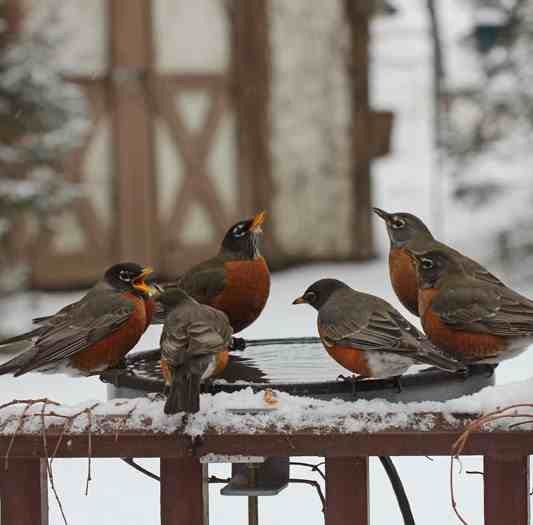
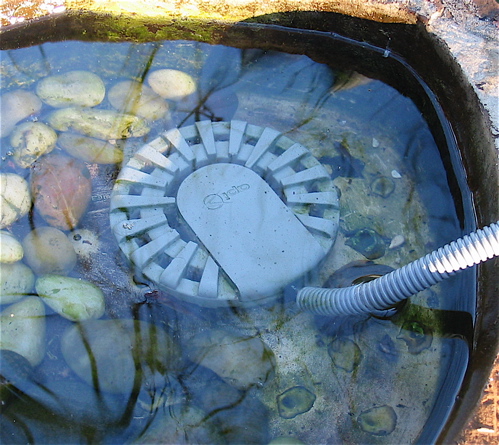


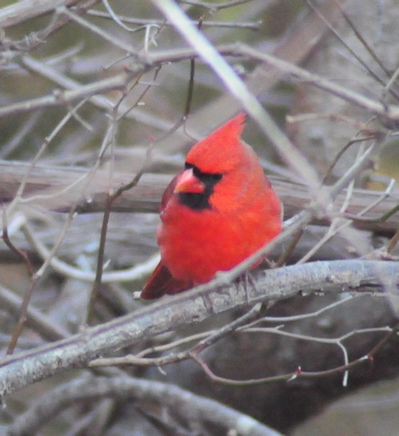 You know when puffed up, big fat birds are hanging around feeders and they resemble little fluff balls? Feathers are fluffed as a way to trap heat beneath them close to the birds’ body. It’s one of the main reasons for late summer/fall molt when they shed old and tattered feathers. New feathers are sturdy, sometimes even brighter and more effective at keeping the bird warm.
You know when puffed up, big fat birds are hanging around feeders and they resemble little fluff balls? Feathers are fluffed as a way to trap heat beneath them close to the birds’ body. It’s one of the main reasons for late summer/fall molt when they shed old and tattered feathers. New feathers are sturdy, sometimes even brighter and more effective at keeping the bird warm.
